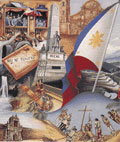
Nueva Vizcaya is a province in the Philippines located in the Cagayan Valley region in Luzon. Its capital is Bayombong. It is bordered by Benguet to the west, Ifugao to the north, Isabela to the northeast, Quirino to the east, Aurora to the southeast, Nueva Ecija to the south, and Pangasinan to the southwest. Quirino province was created from Nueva Vizcaya in 1966.

Benguet, officially the Province of Benguet, is a landlocked province of the Philippines located in the southern tip of the Cordillera Administrative Region in the island of Luzon. Its capital is La Trinidad.

Ifugao is a landlocked province of the Philippines in the Cordillera Administrative Region in Luzon. Its capital is Lagawe and it borders Benguet to the west, Mountain Province to the north, Isabela to the east, and Nueva Vizcaya to the south.

Mountain Province is a landlocked province of the Philippines in the Cordillera Administrative Region in Luzon. Its capital is Bontoc.
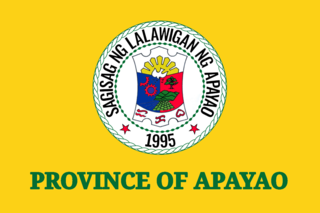
Apayao is a landlocked province in the Philippines in the Cordillera Administrative Region in Luzon. Its capital town is Kabugao.

Kalinga is a landlocked province in the Philippines situated within the Cordillera Administrative Region in Luzon. Its capital is Tabuk and borders Mountain Province to the south, Abra to the west, Isabela to the east, Cagayan to the northeast, and Apayao to the north. Kalinga and Apayao are the result of the 1995 partitioning of the former province of Kalinga-Apayao which was seen to better service the respective needs of the various indigenous peoples in the area.

Kalinga-Apayao was a province of the Philippines in the Cordillera Administrative Region in the island of Luzon. It was divided into the two provinces of Kalinga and Apayao with the passage of Philippine Republic Act No. 7878 on February 14, 1995. This RA amended the earlier Republic Act No. 4695, passed on June 18, 1966, which formed the provinces of Kalinga-Apayao, Benguet, Ifugao, and Mountain Province, from the earlier Mountain Province.

Cordillera Administrative Region (CAR), also known as Cordillera Region, is an administrative region in the Philippines, situated within the island of Luzon. The only landlocked region in the insular country, it is bordered by the Ilocos Region to west and southwest, and by the Cagayan Valley Region to the north, east, and southeast. It is the least populous region in the Philippines, with a population less than that of the City of Manila.

The Cordillera Central or Cordillera Range is a massive 320 km long north-south, 118 km width east-west. Cordillera mountain range situated in the northern central part of the island of Luzon, in the Philippines. The mountain range encompasses all provinces of the Cordillera Administrative Region, as well as portions of eastern Ilocos Norte, eastern Ilocos Sur, eastern La Union, northeastern Pangasinan, western Nueva Vizcaya, and western Cagayan.

The Igorot, or ethnolinguistic groups in the Cordilleras, are any of various ethnic groups in the mountains of northern Luzon, Philippines, all of whom keep, or have kept until recently, their traditional religion and way of life. Some live in the tropical forests of the foothills, but most live in rugged grassland and pine forest zones higher up. The Igorot numbered about 1.5 million in the early 21st century. Their languages belong to the northern Luzon subgroup of the Philippine languages, which belong to the Austronesian (Malayo-Polynesian) family. There are nine main ethnolinguistic groups in the Cordilleras. The Cordillera Administrative Region is located in Luzon and is the largest region in the Philippines.
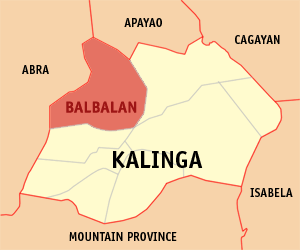
Balbalan, officially the Municipality of Balbalan is a 3rd class municipality in the province of Kalinga, Philippines. According to the 2015 census, it has a population of 12,195 people.
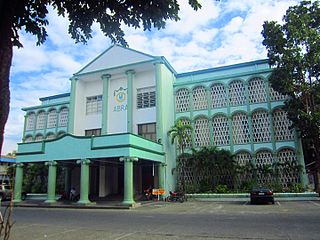
Abra, officially the Province of Abra, is a province in the Cordillera Administrative Region of the Philippines. Its capital is the municipality of Bangued. It is bordered by Ilocos Norte on the northwest, Apayao on the northeast, Kalinga on the mid-east, Mountain Province on the southeast, and Ilocos Sur on the southwest.

The Rice Terraces of the Philippine Cordilleras were inscribed on the UNESCO World Heritage List in 1995, the first-ever property to be included in the cultural landscape category of the World Heritage List. This inscription has five sites: the Batad Rice Terraces, Bangaan Rice Terraces, Mayoyao Rice Terraces, Hungduan Rice Terraces and Nagacadan Rice Terraces, all in Ifugao Province, Philippines. The Ifugao Rice Terraces reach a higher altitude and were built on steeper slopes than many other terraces. The Ifugao complex of stone or mud walls and the careful carving of the natural contours of hills and mountains to make terraced pond fields, coupled with the development of intricate irrigation systems, harvesting water from the forests of the mountain tops, and an elaborate farming system.
The legislative district of Mountain Province is the representation of Mountain Province in the various national legislatures of the Philippines. The province is currently represented in the lower house of the Congress of the Philippines through its lone congressional district.
The Meso-Cordilleran languages are a group of languages spoken in or near the Cordillera Central mountain range in Northern Luzon. Its speakers are culturally very diverse, and include the lowland Pangasinense, the Igorot highlanders, and Alta-speaking Aeta groups.
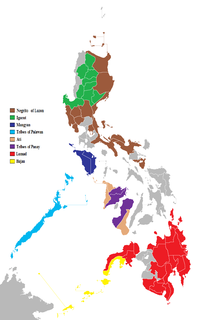
The Philippines consist of numerous upland and lowland indigenous ethnolinguistic groups living in the country, with Austronesians making up the overwhelming majority, while full or partial Australo-Melanesians scattered throughout the archipelago. The highland Austroneians and Australo-Melanesians have co-existed with their lowland Austronesian kin and neighbor groups for thousands of years in the Philippine archipelago. The primary difference is that they were not absorbed by centuries of Spanish and United States colonization of the Philippines, and in the process have retained their customs and traditions. This is mainly due to the rugged inaccessibility of the mountains and established headhunting and warrior cultures, which discouraged Spanish and American colonizers from coming into contact with the highlanders.

The pasiking is the indigenous basket-backpack found among the various ethno-linguistic groups of Northern Luzon in the Philippines. Pasiking designs have sacred allusions, although most are purely aesthetic. These artifacts, whether handwoven traditionally or with contemporary variations, are considered exemplars of functional basketry in the Philippines and among Filipinos.
Eduardo Masferré was a Filipino-Catalan photographer who made important documentary reports about the lifestyle of native people in the region of the Cordillera in the Philippines at the middle of 20th century. He is regarded as the Father of Philippine photography.
The Apostolic Vicariate of Tabuk is a Latin Rite Catholic missionary pre-diocesan jurisdiction in the Philippines covering the provinces of Kalinga and Apayao in northern Luzon.

A plebiscite for the ratification of the organic act creating the Cordillera Autonomous Region was held on January 30, 1990, to ask if the voters in the Cordillera Administrative Region wanted to be an autonomous region under Republic Act No. 6766. The Cordillera Administrative Region (CAR) consists of the provinces of Abra, Benguet, Ifugao, Kalinga-Apayao, and Mountain Province, and the city of Baguio. Only Ifugao voted in favor of autonomy, and a Supreme Court case later disallowed the creation of an autonomous region with just one province.
